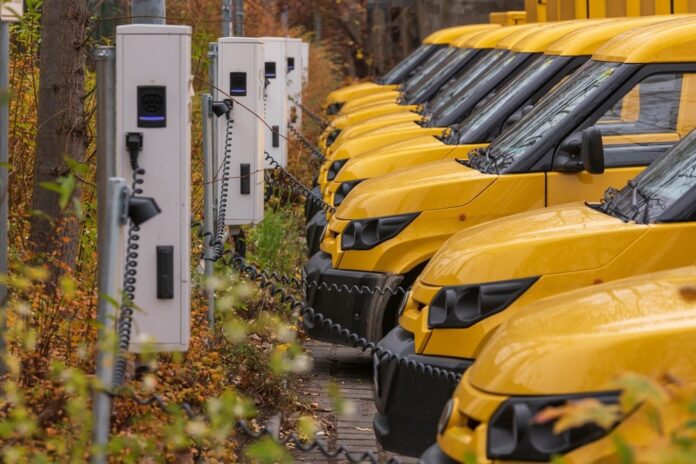Electric vehicles (EVs) are often hailed as a cleaner alternative to traditional internal combustion engine (ICE) vehicles, particularly in pushing to reduce global carbon emissions. However, assessing their actual environmental impact requires a deeper look beyond tailpipe emissions. Factors such as raw material extraction, battery production, energy sources for charging, and recycling practices all play a role in determining how clean EVs are.1,2
Image Credit: Ronald Rampsch/Shutterstock.com
An Overview of Electric Vehicles
Governments worldwide are increasingly promoting EVs as a solution to climate change and energy security challenges. They offer several advantages over traditional combustion vehicles. One of the most significant is zero tailpipe emissions, as EVs do not emit pollutants like carbon dioxide or nitrogen dioxide.
Their manufacturing processes are also more environmentally friendly. EVs also feature simpler and more compact engines, which do not require components such as gearboxes, clutches, or cooling systems. This mechanical simplicity results in lower maintenance costs and improved reliability, as fewer moving parts are subject to wear and tear.1,2
EVs provide a smoother and quieter driving experience, free from the noise and vibrations associated with ICEs. In terms of efficiency, EVs significantly outperform traditional vehicles.
While gasoline vehicles achieve a total well-to-wheel efficiency between 11% and 27%, and diesel vehicles between 25% and 37%, EVs powered by natural gas plants achieve between 13% and 31%.
Notably, EVs powered by renewable energy can reach efficiencies up to 70%. Additionally, EVs grant drivers access to restricted urban areas, such as low-emission zones, further increasing their appeal.2
Several types of EVs are currently in use, differentiated by their technologies. Battery electric vehicles (BEVs) run entirely on electric power with no combustion engine or fuel. Plug-in hybrid electric vehicles (PHEVs) combine an electric motor with a combustion engine and can be externally charged. Hybrid electric vehicles (HEVs) use both systems but cannot be plugged in.2
Environmental Issues with EV Production
EVs have emerged as symbols of sustainability due to their zero tailpipe emissions, distinguishing them from traditional ICE vehicles. Their environmental appeal extends beyond their use, encompassing sustainable design, choice of materials, energy efficiency during operation, and the potential for component recycling. Yet, recent studies presented a more critical view of EVs’ overall sustainability, especially considering their full life cycle, including production, usage, and end-of-life disposal.2
The production phase of EVs is notably energy-intensive, particularly due to battery manufacturing. It can take more energy to produce an EV than a conventional one. This is due to the mining and processing of essential minerals like lithium, cobalt, copper, manganese, and rare earth elements like neodymium.
Click here to download this article for later reading
Manufacturing lithium-ion batteries using current technology requires between 350 to 650 megajoules of energy per kWh. Each kWh of battery capacity results in 150 to 200 kg of carbon dioxide emissions. For instance, producing a 22 kWh battery for a BMW i3 can emit nearly three tons of carbon dioxide.2
The sourcing of raw materials also poses environmental and ethical challenges. Cobalt mining, primarily in the Democratic Republic of Congo, caused serious health risks and environmental contamination due to hazardous waste by-products. Smelting these metals also releases harmful pollutants like sulfur oxides into the air.3
Similarly, lithium extraction from salt flats in Argentina, Bolivia, and Chile consumes large quantities of groundwater, reducing availability for local communities and ecosystems. The EV production water footprint is approximately 50% greater than that of conventional vehicles. Rare earth extraction, especially in China, adds further concerns as it often involves radioactive elements that can contaminate air and water sources.3
Post-Production Emissions of Electric Vehicles
EVs are often considered cleaner alternatives to ICE vehicles, but their environmental impact heavily depends on how electricity is generated. While EVs do not emit greenhouse gases/nitrogen dioxide, the electricity used to charge them can come from fossil-fuel power plants, diminishing their climate benefits.2
For instance, countries like Germany still rely significantly on coal and gas for power. Therefore, renewable energy is crucial, especially for charging and manufacturing. Storing renewable energy like solar and wind power for peak charging times can lower environmental impact and reduce charging costs.2
A tool developed by Massachusetts Institute of Technology (MIT) researchers helps compare the climate impacts of different vehicle models by considering emissions from vehicle manufacturing, fuel production, and the electricity mix for EV charging. EVs are significantly greener when charged on the average United States (US) grid, which includes both fossil fuels and renewables. For instance, the all-electric Chevrolet Bolt produces about 189 grams of carbon dioxide per mile over its lifetime compared to 385 g/mile for a gasoline Toyota Camry and 636 g/mile for a Ford F-150.3
However, results vary by region. In areas with coal-heavy electricity grids, like parts of the US Midwest, charging an EV like the Chevrolet Bolt can be less climate-friendly than driving a HEV like the Toyota Prius. However, it still outperforms conventional gasoline-powered vehicles.3
In China, EVs reduce greenhouse gas emissions by 20%, but increase pollutants such as particulate matter with diameters less than 10 micrometers, particulate matter with diameters less than 2.5 micrometers, nitrogen oxides, and sulfur dioxide, mainly due to coal-based power generation.4
EVs tend to be 24% heavier than ICE vehicles, which increases non-exhaust emissions such as tire, brake, and road wear by about 50%. The environmental impact also varies by EV type. BEVs with large battery capacities can emit 2–3 times more greenhouse gases than HEVs, depending on the timing and source of grid power used for charging.4
Challenges in Battery Recycling
As EVs age, managing used lithium-ion batteries is becoming a major challenge. Unlike lead-acid batteries, 99% of which are recycled in countries like the US., only about 5% of lithium-ion batteries are currently recycled. These batteries contain valuable metals, but recycling them can be resource-intensive.
Two key recycling methods exist: pyrometallurgical, which uses high heat but consumes a lot of energy, and hydrometallurgical, which involves chemical leaching but requires pre-processing and water.2,3,5
Battery chemistry and design variations complicate recycling, and the risk of fire from damaged or improperly discharged batteries adds safety concerns. An alternative solution is repurposing old EV batteries for stationary energy storage.
Although batteries lose effectiveness for driving when capacity drops below 80%, they can still be useful in less demanding applications like grid storage, where range is not a critical issue.5
What Does the Future Hold for Electric Vehicles?
In conclusion, while electric vehicles offer substantial benefits in reducing tailpipe emissions and improving energy efficiency, their full environmental impact depends on factors such as energy sources, battery production, and end-of-life management.
Cleaner electricity grids and improved recycling practices are essential to maximizing their sustainability. As technology and infrastructure evolve, EVs have the potential to play a key role in a cleaner transportation future.
References and Further Reading
Alanazi, F. (2023). Electric Vehicles: Benefits, Challenges, and Potential Solutions for Widespread Adaptation. Applied Sciences, 13(10), 6016. DOI: 10.3390/app13106016, https://www.mdpi.com/2076-3417/13/10/6016
Sanguesa, J. A., Garrido, P., Martinez, F. J., M., J. (2021). A Review on Electric Vehicles: Technologies and Challenges. Smart Cities, 4(1), 372-404. DOI: 10.3390/smartcities4010022, https://www.mdpi.com/2624-6511/4/1/22
Tabuchi, H., Plumer, B. (2021). How green are electric vehicles. The New York Times. https://www.nytimes.com/2021/03/02/climate/electric-vehicles-environment.html
Requia, W. J., Mohamed, M., Higgins, C. D., Arain, A., & Ferguson, M. (2018). How clean are electric vehicles? Evidence-based review of the effects of electric mobility on air pollutants, greenhouse gas emissions and human health. Atmospheric Environment, 185, 64-77. DOI: 10.1016/j.atmosenv.2018.04.040, https://www.sciencedirect.com/science/article/abs/pii/S1352231018302711
How well can electric vehicle batteries be recycled? (Online) Available at https://climate.mit.edu/ask-mit/how-well-can-electric-vehicle-batteries-be-recycled (Accessed on 08 May 2025)


